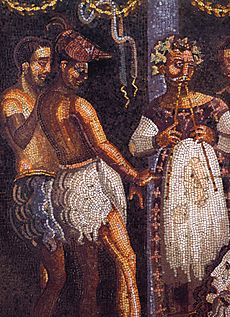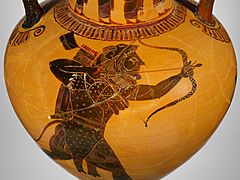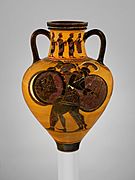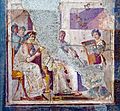Aulos facts for kids
| Classification | Double reed |
|---|---|
| Related instruments | |
The aulos (pronounced AW-los) was an ancient Greek wind instrument. It was often shown in Ancient Greek art and found by archaeologists.
Even though aulos is often translated as "flute," it was usually a double-reed instrument. Its sound was strong and exciting, more like a bagpipes. It had a main pipe (called a chanter) and a pipe that played a continuous low note (a drone).
An aulete was the musician who played the aulos. The ancient Roman version was called the tibicen. Sometimes, an aulode refers to a singer who sang along with the aulos music.
Contents
What Was the Aulos?
There were different kinds of aulos instruments. Some had a single pipe, and others had two pipes. The most common type used a reed, like a modern oboe. But its mouthpiece was larger, similar to the Armenian duduk.
- A single pipe without a reed was called a monaulos.
- A single pipe held sideways, like a modern flute, was a plagiaulos.
- A pipe with a bag for continuous sound, like a bagpipe, was an askaulos.
How Was the Aulos Used?
The aulos was used for many things in ancient Greece. It was sometimes played for military music, much like the Great Highland Bagpipe. Its loud sound could be heard over the noise of marching soldiers.
However, it was more often used in other parts of daily life:
- It provided music for emotional elegiac poetry.
- It accompanied sports like wrestling, the broad jump, and discus throwing.
- It helped rowers keep time on trireme ships.
- It was played during sacrifices and plays.
Plato, a famous Greek thinker, thought the aulos was too wild. He linked it to the energetic worship of Dionysus. He banned it from his ideal city in his book Republic, but allowed it in his Laws.
Tools for Aulos Players
Aulos players used a tool called the Phorbeia or Capistrum. This device had two straps. One went over the head, and the other around the back of the head, stretching from ear to ear. It helped support the player's cheeks.
The phorbeia allowed musicians to use a technique called circular breathing. This let them play continuously without stopping for breath. It might also have helped keep the instrument's reeds from falling down the player's throat. Another idea is that it helped hold the lips steady, reducing strain on the lip muscles.
Famous Aulos Players
While some wealthy people played the aulos for fun, it became mostly a job for professional musicians. These musicians were often slaves, but they could still become very famous.
A Roman-Greek writer named Lucian wrote about aulos playing. He tells a story about Alexander the Great's aulos player, Timotheus. Timotheus advised his student, Harmonides, to impress other expert musicians rather than just seeking fame from big crowds. He said that if leading musicians admired him, popular approval would follow. Sadly, Lucian reported that Harmonides died from blowing too hard while practicing!
The Myth of Marsyas and the Aulos
In Greek myths, the satyr Marsyas is said to have invented the aulos. Another story says the goddess Athena threw it away because playing it made her cheeks puff out, ruining her beauty. Marsyas then found it.
Marsyas challenged the god Apollo to a music contest. The winner could do anything they wanted to the loser. Apollo played his lyre, and Marsyas played his aulos. Apollo won. As punishment, Apollo tied Marsyas to a tree and killed him.
King Midas was cursed with donkey's ears because he thought Marsyas was the better player. Marsyas's blood and the tears of the Muses (goddesses of inspiration) formed the river Marsyas.
This myth was a warning against "hubris" (pronounced HYOO-bris), which means extreme pride. Marsyas was too proud to think he could beat a god. This story also shows how the ancient Greeks saw the lyre and aulos differently. The lyre often represented calm and reason, while the aulos represented wildness and strong emotions. However, this idea of a simple difference between the two instruments is mostly from later interpretations. In reality, both instruments were important in different ways. For example, at Sparta, the aulos was even played when soldiers went into battle.
Aulos in Ancient Art
Chigi Vase Depiction
The Chigi vase shows a battle scene where an aulos player sets a rhythm for soldiers. This music helped the soldiers keep their formation tight. The aulete was very important for making sure the soldiers stayed together.
Herakles' Tenth Labor
An ancient pot (amphora) from around 540–530 BC shows Herakles doing his tenth labor. Aulos players can be seen in a procession on the neck of the pot.
The Aulos Today
Scientists are now using computers to recreate the sounds of the aulos. This project is called Ancient Instruments Sound/Timbre Reconstruction Application (ASTRA). It uses special computer models to make the sounds. Because this is very complex, the ASTRA project uses many computers across Europe at the same time.
The aulos is part of the Lost Sounds Orchestra. This group plays sounds from ancient instruments that ASTRA has recreated.
The aulos has also appeared in movies. You can see it in the 2009 film Agora and the 2007 movie 300.
Modern versions of the aulos are still played in some parts of Southeastern Europe. In southern Albania, there's an instrument called the cula diare or longari. It looks like a double aulos and is used to play traditional music. However, these modern instruments are usually woodwind instruments, not double-reeded like the ancient aulos.
Gallery
-
An ancient painting from Herculaneum showing an actress singing, an actor playing aulos, and a girl playing a cithara.
See also
 In Spanish: Aulós (instrumento) para niños
In Spanish: Aulós (instrumento) para niños
- The Reading Aulos
- Launeddas
- Zampogna
- Arghul
- Triple pipes












